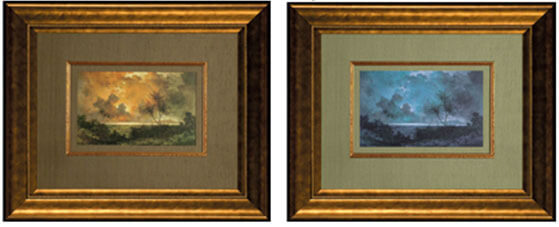How to Use Conservation Grade Glass or Acrylic Framing
The design on the left shows this framed art in its original state. Due to damage
from ultra-violet lighting (either sun or artificial light) the art and mat faded to
look we see at the right.
Conservation grade glazing protects from most of the harmful light rays. By
investing a bit more in protective glazing, you will maintain the integrity of your
framed art and increase its longevity. (see image below)
Framing Tip: Mat Border Proportions
Mat border widths change in popularity somewhat like hemlines
on dresses. The current style is the use of wider borders than
the typical borders used 10 or 20 years ago.
Today many people look at mats as an opportunity to add
color to the frame design, but originally mats were neutral in color
and used to provide visual relief between the art and its
surroundings. More generous mat borders enable you to focus on
the art much more easily.
What is a Fillet?
A fillet is a decorative accessory that can be inserted into the opening
of a mat or the lip of a frame. When used with a mat, it is most common
to choose a fillet that coordinates with the color and style of the frame.
However, when you want to add a fillet inside the frame, contrast is
most desirable. Fillets are available in a wide variety of colors, styles,
and widths for all of your framing needs. We are always happy to show
you our selection.
Choosing a Frame Color
Several methods are used when selecting appropriate frame colors,
including:
• Match or coordinate a dominant color in the art
• Relate to the color temperature of the art. Red, orange and yellow
are warm colors so they coordinate with gold or wood tone frames.
Blue, green and purple are cool colors and they relate more to silver
or gray frames.
• For historical pieces, we often suggest using the finish color that
would have been used originally when the piece was new.
Appropriate Frame Width
Many people assume that narrow frame mouldings are for small
pictures and larger works of art should be paired with wider frame
mouldings. That isn’t always the case. Wider frames can benefit smaller
pieces of art by calling attention to them. The width of a frame can also
be used to relate the framed art to the scale of your room or furnishings
– don’t overpower a room with a frame that’s too large for the space or
under-power the artwork with too petite a frame.

